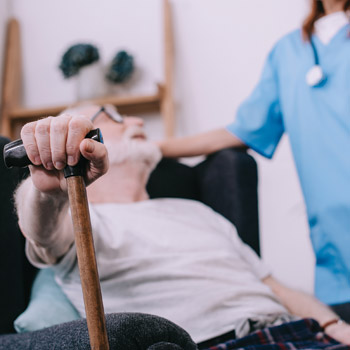A shifting focus on the role of patients' nonmedical needs
Two ACP position papers offer guidance on the role primary care physicians can play in addressing traditionally nonmedical issues, often known as the social determinants of health, and how they encourage the development of patient-centered care.
Few physicians would argue against patients being at the center of modern medical care, but getting at social factors that could be affecting their health and working together to improve these issues can be a challenge, especially within the confines of a short primary care visit.
Do they have access to healthy food? A clean, safe home? Reliable transportation? To address such questions, ACP published two position papers in 2018 in Annals of Internal Medicine that offer guidance on the role primary care physicians can play in addressing traditionally nonmedical issues, often known as the social determinants of health, and on how they can partner with patients to learn their priorities and help them achieve their goals.

The release of these two papers only months apart was somewhat coincidental, as independent committees of the College created them. But they show ACP's priorities to encourage the development of a greater patient-centered culture, said Steven E. Weinberger, MD, MACP, EVP/CEO Emeritus of ACP and adjunct professor of medicine at the University of Pennsylvania in Philadelphia.
ACP prioritized its patient-centered focus in 2013 when it established the Center for Patient Partnership in Healthcare. Over the past few years, ACP's policy team in Washington has also recognized the importance of social determinants of health, not only from an individual physician point of view but also in an advocacy and public policy role.
The full spectrum of physicians in ACP's membership base, both primary care physicians and subspecialists, positions it well to focus on these topics at the present time, Dr. Weinberger added.
The papers
The first paper, “Addressing Social Determinants to Improve Patient Care and Promote Health Equity,” published in April 2018, notes that poor environments contribute to negative health outcomes but that investments in areas such as housing, food, income support, and care coordination yield results.
“Physicians, policymakers, communities, and individuals should understand the role [social determinants of health] play in individual and community health and strive to implement public policies that reach the largest number of people while targeting the day-to-day needs of individuals in their communities. …Awareness of social determinants of health may not always translate into better health outcomes, but it is an important component of the physician's role as an advocate for patients and a steward of medical care,” it said.
Among its specific recommendations were crafting public policy interventions to address environmental, geographical, occupational, educational, and nutritional issues that hurt patients; integrating knowledge about such issues into all levels of medical education; increasing team-based approaches to help patients; and adjusting payment models to reflect the increased responsibilities that come with caring for disadvantaged patient populations.
Along somewhat similar lines, “Principles for Patient and Family Partnership in Care,” published in December 2018, calls for patients and families to be treated with dignity and respect and to be active partners in both their care and in the training of health care professionals.
Specific recommendations include asking patients how they prefer to be addressed, using language that the patient can understand, listening without interruption, developing a shared agenda for visits, and promoting patient engagement and self-management.
Putting it into practice
These suggestions have the potential to benefit patients, but many physicians may struggle to find the time and resources to take action.
Sue Bornstein, MD, FACP, coauthor of the social determinants paper, 2018-2019 Chair of ACP's Health and Public Policy Committee, and executive director of the Texas Medical Home Initiative in Dallas, stresses that these efforts shouldn't and can't fall solely on clinicians' shoulders.
“None of us wants clinicians to feel like, ‘Here's one more thing that I'm going to be asked to do in my daily work, which is already overwhelming for me,’” she said. “Looking into and understanding social determinants to help patients cannot just be in the purview of the physician. We need a team-based approach in all of primary care.”
For example, she suggested practices create or use an existing screening tool to query patients about issues such as food insecurity and domestic violence. Front desk staff or nursing staff can ask them to complete this before the physician visit, and results can often be uploaded into the electronic medical record.
Responding to troubling findings is a challenge, of course, but social workers or case managers can and should be called upon when serious issues such as homelessness or abuse are identified, she said.
Martina Jelley, MD, MSPH, FACP, agreed that having a supportive team is key to a physician's success in this realm.
“Helping somebody get back in an apartment is not the job for the doctor. This really is where a patient-centered medical home comes into action,” said Dr. Jelley, who is professor and vice chair for research at the department of internal medicine and assistant dean for clinical research at the University of Oklahoma School of Community Medicine in Tulsa.
Dr. Weinberger suggested looking for partnership opportunities in a wide range of areas, including the nursing community, the pharmacy community, the social work community, and the broader social services landscape.
“For many years, clinicians were just viewed as practicing independently. But more and more, we recognize that health care is a team sport, not an individual sport,” he said. “That type of holistic approach is incredibly important for our efforts to help maximize our patients' health and well-being.”
Dr. Bornstein recommends that practices that want to increase their work on nonmedical issues start by taking an incremental approach. She suggested they analyze the issues their patient base is most likely to face and gather information about community resources around those specific needs.
“Really look at the community that your practice is in. Is it in an affluent urban center? Then maybe social determinants are not such an important factor in your population's health. Is it in a resource-challenged urban community? Then you need to consider what issues your patients are probably dealing with and prioritize them,” she said. “We cannot meet every single need out there, but I think if you can do an environmental scan and understand the community that your patients live in, you have a better chance of being effective.”
(For more suggestions, see the Practice Tips column in this issue.)
Training yields results
Dr. Jelley feels strongly about one specific social determinant that isn't always front of mind for practitioners: the role that childhood trauma plays in adult health. Her team has used simulation training to help all levels of clinicians, from medical students to faculty, learn to broach this sensitive subject for several years, and she said the results are clear. (For more on this subject, see “Breaking the Cycle of Patient Trauma” in the February 2019 ACP Internist.)
“We have standardized patients who play the role of a somewhat difficult patient who has multiple chronic health issues or the one that never seems to take care of themselves and keeps ending up in the hospital,” she said. “We give [the trainees] an opportunity to practice bringing up the topic and connecting the patient's current symptoms to their past, and then working with the patient to address whatever might work best for them.”
She has seen a real jump in terms of doctors' willingness to ask these types of tough questions as more medical education programs adopt training such as the one at the University of Oklahoma.
“There was a time we only asked if patients smoked, drank, or had a job. That was it,” she said. “Unless you are willing to ask things like how they got to the clinic today or who is their social support system or if they have access to quality food, it's impossible to care for patients very well.”
Helping patients deal with the lingering effects of childhood trauma has another benefit, she added: Many of them did not have a good role model for how to parent and are therefore at heightened risk of mistreating their own children.
“The best way we can help future generations is to stop this cycle,” she said.
Challenges
Some physicians may view the concepts of patient partnership and advocacy about social determinants of health to be “mission creep” for a busy practitioner, but Dr. Weinberger, who was a coauthor on the patient partnership paper, discourages that type of thinking.
“I definitely do not think that it represents ‘mission creep’ for physicians to address those sorts of things because they are so important for the health and well-being of the patient,” he said. “Problems such as inadequate nutrition or living in an environment where a person may be subject to violence have such a huge impact that it is being an incomplete physician and caretaker if we do not address them.”
Dr. Bornstein said an important aspect in avoiding the “creep” is to identify ways to offer help without medicalizing every patient's issues.
“Not every problem that people have is a medical problem. We need to recognize the danger that a strictly medical approach to nonmedical issues could paradoxically lead to more health care versus other cost-effective interventions just because it's taking place in a physician's office,” she said.
While some patients would be thrilled if their physician was interested and offered partnership to help with problems such as mold in their home or living in a food desert, others will resist opening up. Gentle questioning, patience, and always leaving the door open are helpful approaches, the experts said.
In fact, creating such a welcoming environment for patients to talk is what internists do best, Dr. Bornstein said.
“You have to gain your patients' trust before you can talk to them about smoking, or their drug and alcohol use. You may not be able to do it the first time you see them, but primary care at its best is relationship-based. Demonstrate that you really care about them—not just about their physical health, but about their entire health,” she advised.
Dr. Weinberger stressed that physicians need to let patients know they are interested in them as people and suggested setting the stage by asking questions that really go beyond “What are you here for today?”
“Showing a real personal interest helps establish that sense of trust, where the patient feels more comfortable with exploring those issues, as opposed to seeing the doctor as a noncaring person who's going through a question list,” he said.
If issues arise that cannot possibly be addressed in a short office visit, encourage patients to come back for another visit, he added.
Beyond the office visit
In a 2018 editorial accompanying the social determinants position paper, David Himmelstein, MD, FACP, and Steffie Woolhandler, MD, MPH, argued that many health disparities are deeply rooted in societal causes, such as high levels of incarceration of minorities, fear of deportation that causes immigrants to avoid seeking care, and the high financial costs of health care for the uninsured. The editorial disputed the notion that social determinants are individual problems, instead pointing to the unequal distribution of wealth and power in the U.S.
Dr. Himmelstein, distinguished professor of public health and health policy at CUNY School of Public Health at Hunter College in New York, adjunct clinical professor at Albert Einstein College of Medicine in Bronx, N.Y., and lecturer in medicine at Harvard Medical School in Boston, advises that physicians keep this in mind when talking to patients.
An advocate for single-payer health care, he encourages physicians to pose their questions in a way that makes clear they aren't blaming patients for their problems but rather view them as a sign that society isn't taking proper care of some of its members. For example, he said, some public housing in New York lacks adequate heat and hot water. People living there often have no other options but to suffer through.
But he cautioned that doctors need to avoid focusing so much on these issues that they consume a short office visit instead of using the time to address the often serious problems that brought the patient to the office in the first place.
“We need to be patient-centered and not reorient medical care in a way that is problematic for people who are already in trouble,” he said.
Overall, though, Dr. Himmelstein said he is skeptical about physicians' ability to do anything significant about these problems on an individual level, especially if they are in a practice that does not include social workers or similar support staff. He urges higher-level advocacy instead.
“Changing society is the best way we can change the social determinants of health,” he said. “Doctors can play a significant role in speaking up about the fact that the ways we are organizing society don't make sense. Their voices can be very powerful.”




